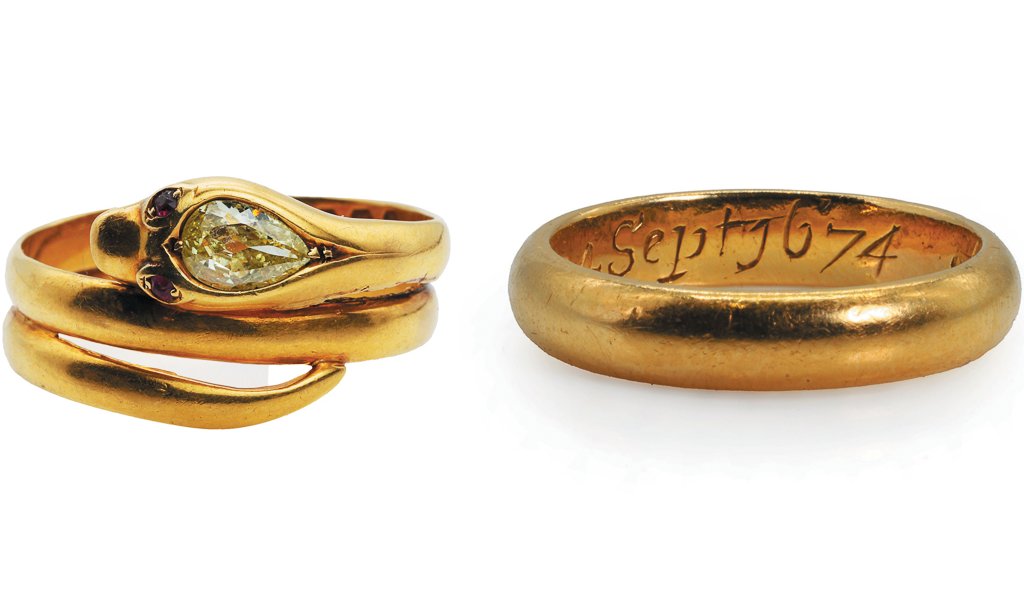TWO fabulous results for two quite different gold rings – dramatic proof why going to auction is the best bet!
There are two bits of good news regarding these rings: as they made six times the value of the gold content at £1,800 and £1,700 respectively. The value of the gold content for each ring is approximately £320, proving that the antique value is so much greater.
Also, from the ecologically perspective, the saleroom has very obligingly calculated the amount of carbon CO2 emissions the buyer has saved by buying an antique ring compared to buying a new ring. The saving is 0.42 tonnes of CO2e, for each ring and if you want to visualise this, it is roughly the size of a double decker bus (a tonne of CO2e is about the size of a hot air balloon).
The Victorian 18ct gold snake ring is modelled as a coiled snake and set with an old pear-shaped light-yellow diamond to the head and with ruby eyes. Hallmarked for London 1875, it weighs 7.59g and made £1,800 in a recent specialist auction.
Serpent rings have been popular throughout our history, the Ancient Egyptians used serpents as symbols of eternal love. Some original designs feature a snake, eating its own tail as a symbol of the eternal circle of life.
The 350-year-old mourning ring for Antony Lybbe, dated 1674, is an insight into life in the 17th Century. Discovered in Derbyshire, it is unusual to have a background story connected to jewellery that is so old. Antony Lybbe was born in 1607 as the second son to Richard Lybbe, High Sheriff of Oxon. In 1637, he married Mary Keate, the daughter and heir of Leonard Keate of Checkendon. She bore him 13 children and lived until 1692. In 1646, the Committee of the County of Berkshire sequestered the estate of Antony Lybbe, after receiving information that he was suspected of being in ‘Armes against the Parliament’. 1646 is the last year of the English Civil War, fought between Roundheads (Parliamentarians) and Cavaliers (Royalists – supporters of Charles I). He was finally discharged in 1652 upon motion of Mr Blagrave, at Haberdashers’ Hall, London. He died in 1674 and left no will, so his widow took out Letters of Administration to inherit his estate. The ring made £1,700 in the recent specialist auction.
Antony Lybbe lived through the era of the English Civil War when conspiracies abounded. It is fortuitous that nowadays we don’t execute people for supporting the other side.
Editor’s Note: Perhaps you have items of value? If so, it is always worth getting the advice of an Independent Antiques Valuer to assess your art and antiques. Please contact Vivienne on 01629 640210 or 0114 2830292 or 07870 238788. Alternatively, go to www.viviennemilburn.co.uk or email vivienne@viviennemilburn.co.uk
Featured Image:
Left: A Victorian 18ct gold diamond set snake ring, it made £1,800 in the recent specialist auction. Weighing 7.59g it is interesting to note that by buying this antique ring at auction the buyer saved up to 0.42 tonnes of CO2e compared to buying a new ring.
Right: A 17th Century antique mourning ring with skull detailing, engraved ‘Anth. Lybbe Ar: Obijt 24th Sept 1674’. Antony Lybbe lived through the era of the English Civil War. The ring made £1,700 in the recent specialist auction.






